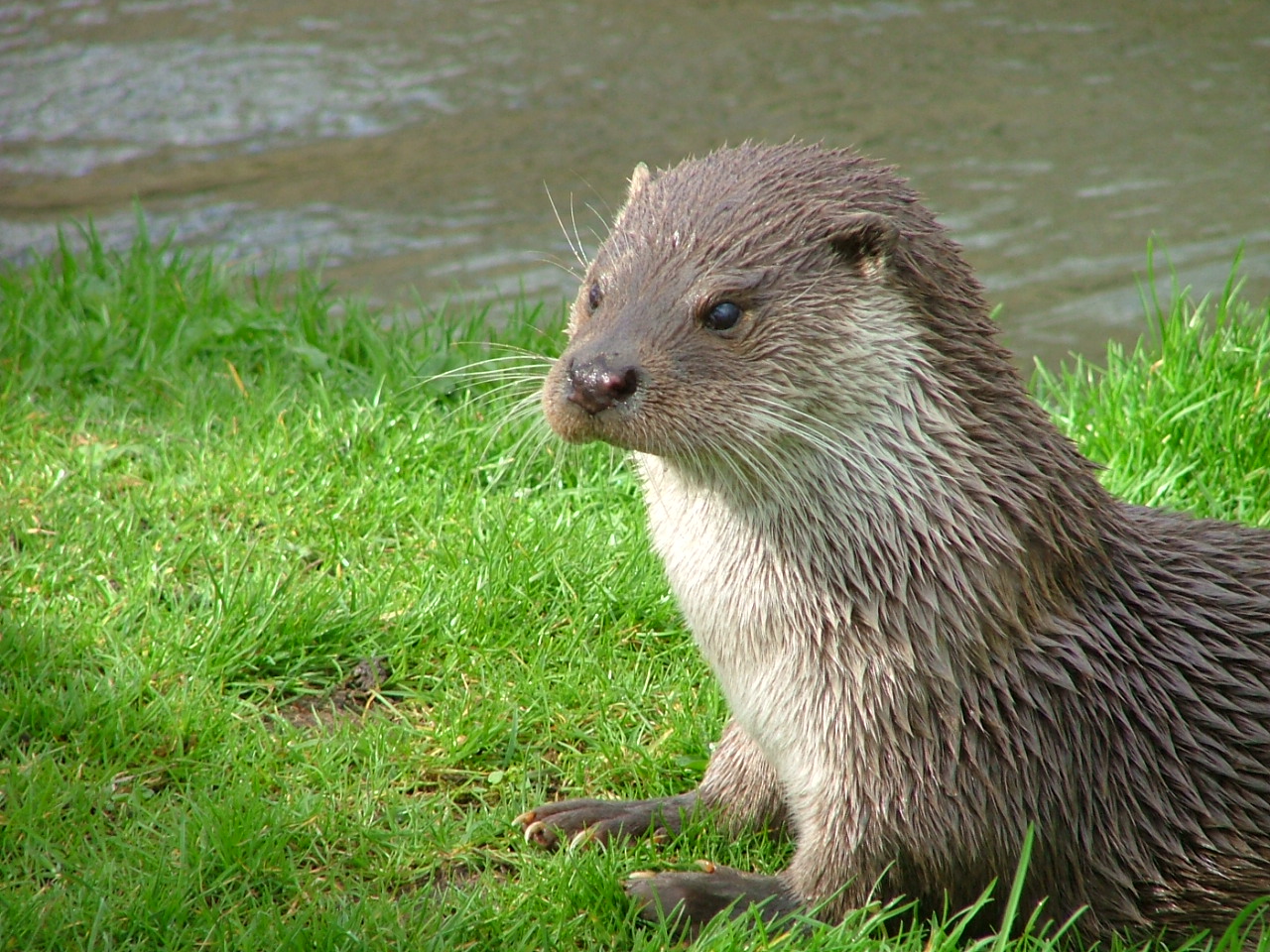- European Otter
Taxobox
name = European Otter
status = NT
status_system = iucn3.1
status_ref = IUCN2007|assessors=Reuther, C. & Hilton-Taylor, C.|year=2004|id=12419|title=Lutra lutra|downloaded=06 May 2008 Database entry includes justification for why this species is near threatened]
trend = unknown

image_width = 250px
regnum =Animal ia
phylum =Chordata
classis =Mammal ia
ordo =Carnivora
familia =Mustelidae
subfamilia = Lutrinae
genus =Lutra
range_
range_map_caption=Range map (note: range also includesBritish Isles )
species = "L. lutra"
binomial = "Lutra lutra"
binomial_authority = (Linnaeus,1758 )The European Otter ("Lutra lutra"), also known as the Eurasian otter, Eurasian river otter, common otter and Old World otter, is a
Europe an andAsia n member of theLutrinae or otter subfamily, and is typical offreshwater otter s.Range and habitat
The European Otter is the most widely distributed otter species, its range including parts of Asia and Africa as well as being spread across Europe. It is believed to be currently extinct in
Liechtenstein ,the Netherlands , andSwitzerland . They are now very common inLatvia , along the coast ofNorway and in Northern Britain, especiallyShetland where 12% of theUK breeding population existFact|date=February 2007 In Italy, they can be found in the Calore river area.The European Otter's diet mainly consists of fish but can also include
bird s,insect s,frog s,crustacean s and sometimes smallmammal s. In general this opportunism means they may inhabit any unpolluted body of freshwater, including lakes, streams, rivers, and ponds, as long as there is good supply of food. European Otters may also live along the coast, in salt water, but require regular access to freshwater to clean their fur. When living in the sea individuals of this species are sometimes referred to as "sea otters", but they should not be confused with the truesea otter , aNorth America n species much more strongly adapted to a marine existence.Behaviour and reproduction
European Otters are strongly territorial, living alone for the most part. An individual's territory may vary between about one and forty kilometres long (about half to 25 miles), with about 18 km (about 11 miles) being usual. The length of the territory depends on the density of food available and the width of the water suitable for hunting (it is shorter on coasts, where the available width is much wider, and longer on narrower rivers). The territories are only held against members of the same sex, and so those of males and females may overlap [http://links.jstor.org/sici?sici=0030-1299%281968%2919%3A1%3C81%3ATOTOLL%3E2.0.CO%3B2-2&size=SMALL&origin=JSTOR-reducePage "Territoriality of the otter Lutra lutra L."] Erlinge, S. (1968), "Oikos", No. 19, 81-98.] . Males and females will breed at any time of the year, and
mating takes place in water. After a gestation period of about 63 days, one to four cubs are born, which remain dependent on the mother for a year. The male plays no direct role in parental care, although the territory of a female with her cubs is usually entirely within that of the male. Hunting mainly takes place at night, while the day is usually spent in the European Otter's (den) – usually a burrow or hollow tree on the riverbank which can sometimes only be entered from under water.Conservation
The European Otter declined across its range in the second half of the
20th Century [ [http://www.english-nature.org.uk/lifeinukrivers/species/otter.html "The Eurasian Otter (Lutra lutra) "] ] primarily due to pollution from pesticides such as organochlorine pesticides (OCs) and polychlorinated biphenyls (PCBs). Other threats included habitat loss and hunting, both legal and illegal [ [http://www.jncc.gov.uk/ProtectedSites/SACSelection/species.asp?FeatureIntCode=S1355 "Otter: Background to selection"] ] European Otter populations are now recovering in many parts of Europe for example in Britain the number of sites with an otter presence increased by 55% between 1994 and 2002 [ [http://www.environment-agency.gov.uk/subjects/conservation/483249/ "Otter survey of England"] ] . Recovery is partly due to a ban on the most harmful pesticides that has been in place across Europe since 1979 [ [http://eur-lex.europa.eu/LexUriServ/LexUriServ.do?uri=CELEX:31979L0117:EN:HTML "Council Directive 79/117/EEC of 21 December 1978"] ] , partly to improvements in water quality leading to increases in prey populations, and partly to direct legal protection under the European Union Habitats Directive. [ [http://eur-lex.europa.eu/LexUriServ/LexUriServ.do?uri=CELEX:31992L0043:EN:HTML "Council Directive 92/43/EEC of 21 May 1992"] ] and national legislation in several European countries [ [http://www.jncc.gov.uk/page-1815 "Species other than birds specially protected under The Wildlife and Countryside Act, 1981: Schedule 5 (Animals)"] ] [ [http://www.internationalwildlifelaw.org/WILDLIFEACT1976_1.html "Wildlife Act 1976 (Ireland)"] ] [ [http://www.otter.org/news/world4.html "Otters of the world"] ] InHong Kong , it is on a protected species under Wild Animals Protection Ordinance Cap 170. They are listed as Near Threatened by the 2001IUCN Red List [ [http://www.iucnredlist.org/search/details.php/12419/summ "Lutra lutra– Near Threatened"] ]European Otters in popular culture
The novel "
Tarka the Otter ", and the film based on it features European Otters. TheRedwall series of books byBrian Jacques also regularly features anthropomorphic otters among its characters; one of the books is even named "The Pearls of Lutra".Notes
References
External links
* [http://www.arkive.org/species/ARK/mammals/Lutra_lutra/ ARKive] Photographs. Videos.
* [http://www.environment-agency.gov.uk/subjects/conservation/483249/?version=1&lang=_e UK Environment Agency website about otters and their return]
* [http://www.ottertrust.org.uk The Otter Trust]
* [http://www.otter.org/ International Otter Survival Fund]
* [http://www.shetlandotters.com Shetland Otters]
Wikimedia Foundation. 2010.
